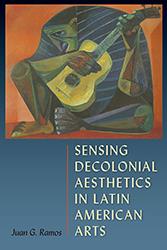This book demonstrates that James Joyce’s Ulysses is a book that imitates the workings of the human mind, connecting close readings of the novel’s text to psychological theories of Joyce’s time.
Buy Books: browse by title
A - B - C - D - E - F - G - H - I - J - K - L - M - N - O - P - Q - R - S - T - U - V - W - X - Y - ZPlease note that while you may order forthcoming books at any time, they will not be available for shipment until shortly before publication date
Juan Ramos uses “decolonial aesthetics,” a theory that frees the idea of art from Eurocentric forms of expression and philosophies of the beautiful, to examine the long decade of the 1960s in Latin America—a time of cultural production that has not been studied extensively from a decolonial perspective.
The Victorian illustrated book came into being, flourished, and evolved during the nineteenth century. Catherine Golden offers a new framework for viewing the arc of this vibrant form and surveys the fluidity in styles of illustration in serial instalments, British and American periodicals, adult and children's literature, and--more recently--graphic novels.
Examining ceramics from eighteenth-century household sites in Jerez de la Frontera, Spain, and St. Augustine, Florida, Setting the Table opens up new interpretations of cultural exchange and identity in the early modern Spanish empire.
This social history explores the romantic and sexual lives of the poor and working class in Mexico City during the rule of dictator Porfirio Díaz, showing how everyday experiences were shaped by broader changes taking place as the Mexican state modernized and underwent capitalist growth and development.
The Shadow of Selma provides a comprehensive assessment of the 1965 civil rights campaign, the historical memory of the marches, and the continuing relevance of and challenges to the Voting Rights Act. The essays consider Selma not just as a keystone event but, much like Ferguson today, as a transformative place: a supposedly unimportant location that became the focal point of epochal historical events.
The first book to examine dance criticism in the United States across 100 years, this study argues that critics in the popular press have influenced how dance has been defined and valued, as well as which artists and dance forms have been taken most seriously.











